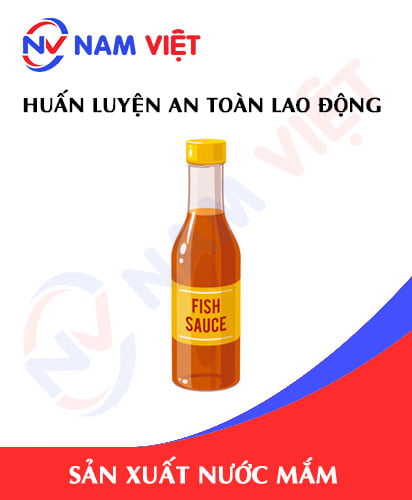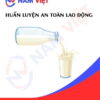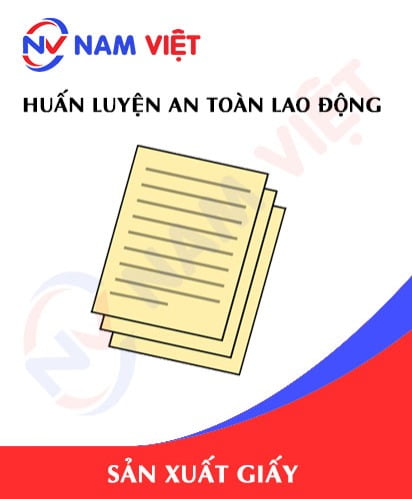Occupational Safety Training for Fish Sauce Manufacturing
99,000 ₫
Note: The price above is calculated per person. Prices may vary depending on the number of trainees participating in the course and market fluctuations. For more accurate pricing support, please refer to the quotation or contact our consultant directly.
Occupational safety is an important issue in fish sauce manufacturing factories and needs to be addressed promptly to ensure the health and safety of workers, and enhance the reputation of businesses. The occupational safety training course is one of the effective solutions to raise awareness on how to prevent workplace accidents for workers involved in production.
Table of Contents
Toggle1. Overview of fish sauce
a. What is fish sauce?
- Fish sauce is a type of seasoning used to enhance the flavor of dishes. Fish sauce is made from fish, usually anchovies, mackerel or herring, and then fermented for a period of time to create a distinctive and delicious flavor. Fish sauce is widely used in Vietnamese and Southeast Asian cuisine.
- Fish sauce is a product mainly manufacturing and consumed in Vietnam, especially in coastal areas. In Vietnam, fish sauce is traditionally manufacturing by fermenting fresh fish. However, currently, the fish sauce manufacturing industry is gradually shifting to industrial manufacturing with new processes and technologies.
- According to data from the General Statistics Office of Vietnam, the domestic consumption of fish sauce in 2020 was estimated at about 253.5 million liters, an increase of 3.3% compared to the previous year. However, the fish sauce manufacturing industry in Vietnam is still under a lot of pressure from competition with imported fish sauce products from Thailand, Cambodia, Indonesia, Korea, Japan, and China.
- To improve manufacturing productivity and quality, many businesses have invested in more modern manufacturing technologies and equipment. However, the issue of quality and food safety of fish sauce remains a top concern for consumers and authorities.

b. Types of machinery for fish sauce manufacturing
The machinery commonly used for fish sauce manufacturing includes:
- Fish grinder: Used to grind fresh fish to extract fish liquid.
- Decomposition tanks: Used to ferment the fish liquid and decompose the remaining substances in the fish liquid.
- Pumping system: To pump water into the decomposition tanks and other fish sauce storage tanks.
- Fish sauce storage tanks: To store fish sauce for the aging process.
- Fish sauce transfer pumping system: Used to transfer fish sauce from the storage tanks to other aging tanks.
- Aging tank system: Used to age the fish sauce with chemicals and spices to create the characteristic flavor of each type of fish sauce.
- Water filter: Used to filter impurities in the fish sauce.
- Fish sauce packaging machine: Used to package fish sauce into bottles or jars for sale.

c. Typical fish sauce manufacturing enterprises
In Vietnam, the fish sauce manufacturing industry is a traditional industry with many traditional fish sauce manufacturing enterprises. Some typical fish sauce manufacturing enterprises in Vietnam include:
- Phu Quoc Shrimp Paste Co., Ltd.: Is one of the largest and most reputable enterprises in the shrimp paste manufacturing industry in Vietnam. The company was established in 1951, with its headquarters in Phu Quoc district, Kien Giang province.
- Nam Ngu Fish Sauce Co., Ltd.: Established in 1950, this is one of the oldest traditional fish sauce manufacturing companies in Vietnam. The company’s headquarters are in Nha Trang city, Khanh Hoa province.
- Hoa Hung Fish Sauce Co., Ltd.: This is a reputable fish sauce manufacturing company in Vietnam. The company was established in 1970, with its headquarters in Hoa Vang district, Da Nang city.
- Soc Trang Shrimp Paste Co., Ltd.: Is one of the leading shrimp paste manufacturing enterprises in the Southwest region. The company was established in 1980, with its headquarters in Soc Trang city, Soc Trang province.
- Chinsu Fish Sauce Co., Ltd.: Is a fish sauce manufacturing enterprise known for the Chinsu brand. The company is headquartered in Ho Chi Minh City, with fish sauce manufacturing factories located in the southern provinces.
d. Specific jobs in a fish sauce manufacturing factory
Group 1
- Executive director, deputy executive director, department head in a fish sauce manufacturing factory.
Group 2
- Safety officer: manages safety in the factory, designs safe procedures, supervises and urges employees to comply with safe work procedures.
Group 3
- Material preparation: The main ingredients are fish and salt. The fish is carefully selected, separated from the head, gutted, washed, and cut into suitable pieces.
- Salting and sun-drying: The fish is salted in a specialized barrel and left for about 20-30 days depending on the type of fish. Then, the fish is sun-dried for about 7-10 days to achieve the desired golden ripeness.
- Filtering, boiling, and distilling: After drying, the fish is taken out and boiled with filtered water in a specialized barrel. Then, the fish liquid is distilled several times to remove impurities.
- Jarring: The fish sauce is bottled in glass jars, with different volumes depending on customer requirements. The jars are sealed, labeled, and packaged for storage and transportation to customers.
- factory hygiene: factory hygiene is an important job, which helps ensure the health of employees and the quality of the product. The areas in the factory need to be cleaned regularly, including the manufacturing area, warehouse, quality control room, restroom, office, and other areas.
Group 4
- Jobs in the office, service, sales, and marketing.
- manufacturing management, quality management, human resource management, material management, financial accounting management.
- Research and development of new products, packaging design.

2. Overview of the occupational safety training course for fish sauce manufacturing
Within the scope of this article, we focus on the issues surrounding Group 3, because Group 3 is the group that directly participates in the manufacturing process, bearing the highest risk of occupational accidents. For more information on other groups, please refer to here
a. What is Group 3 occupational safety training?
- Group 3 occupational safety training is a series of lessons that equip workers with the knowledge to prevent occupational accidents.
- The occupational safety training course will help workers identify and prevent dangers and limit the risks of occupational accidents at work.
REGISTER FOR OCCUPATIONAL SAFETY TRAINING SERVICES
b. Training duration
First-time safety training duration
- The total training duration is at least 24 hours, including the inspection time.
- 8 hours of theoretical study on the system of policies and laws on occupational safety and hygiene
- 8 hours of theoretical study on basic knowledge of occupational safety and hygiene
- 4 hours of theoretical study on specialized training content
- 2 hours of practical study on specialized training content
- 2 hours of theoretical inspection at the end of the training course
The safety training center will divide the time into several training sessions depending on the time arrangement for the employees. But normally, there will be 6 training sessions, the course will take place over 3 days, provided that the manufacturing enterprise can arrange for continuous study time.
Periodic safety training duration
- Before the occupational safety card expires, if an employee wants to have it reissued, they must undergo a periodic occupational safety training course, with the periodic safety training duration being at least 50% of the first-time safety training duration.
Explanation: The total periodic occupational safety training duration is at least 12 hours, including the inspection time. After completing the periodic training course and passing the inspection, the employee will have their occupational safety card reissued or extended.
c. Content of the training course
| No. | TRAINING CONTENT | TRAINING DURATION (HOURS) | |||
| Total | Of which | ||||
| Theory | Practice | Inspection | |||
| I | System of policies and laws on occupational safety and hygiene | 8 | 8 | 0 | 0 |
| 1 | Overview of the system of legal documents on occupational safety and hygiene. | 6 | 6 | ||
| 2 | System of standards and technical regulations on occupational safety and hygiene. | 1 | 1 | ||
| 3 | Specific regulations of state management agencies on occupational safety and hygiene when building new, expanding, or renovating works, facilities for manufacturing, using, storing, and inspecting machinery, equipment, materials, and substances with strict requirements on occupational safety and hygiene. | 1 | 1 | ||
| II | Basic knowledge of occupational safety and hygiene | 8 | 8 | 0 | 0 |
| 1 | Basic knowledge of dangerous and harmful factors in the workplace. | 4 | 4 | ||
| 2 | Methods to improve working conditions. | 1 | 1 | ||
| 3 | Safety culture in manufacturing and business. | 1 | 1 | ||
| 4 | Rights and obligations of employers and employees; policies and regimes on occupational safety and hygiene for employees; functions and duties of the occupational safety and hygiene network. | 1 | 1 | ||
| 5 | Occupational safety and hygiene regulations, safety signs and directions, and the use of safety equipment and personal protective equipment; professional skills and first aid for occupational accidents, prevention of occupational diseases. | 1 | 1 | ||
| III | Specialized training content | 6 | 4 | 2 | 0 |
| General knowledge about types of machines, equipment, and substances that generate dangerous and harmful factors; analysis, evaluation, and management of risks related to occupational safety and hygiene, safe work procedures with machines, equipment, and substances with strict requirements on occupational safety and hygiene. | 6 | 4 | 2 | ||
| IV | Inspection of occupational safety training content at the end of the course | 2 | 2 | 0 | 0 |
| Total | 24 | 22 | 2 | ||
See more training content of 6 groups
d. Occupational safety card
After completing the occupational safety training course and passing the inspection, the employee will be granted an occupational safety card (in practice, also called an occupational safety certificate of group 3).
In which, the group 3 safety card will clearly show information such as: full name, date of birth, specific job and working environment. At the same time, there is also the training time, red stamp and signature to confirm the completion of the training course.
According to the regulations on granting safety cards specified in clause 2 of article 24 of decree 44/2016/ND-CP, it is divided into 2 cases:
- In the case where the employer and the employee have an employment contract with each other, the employer must sign, stamp and seal the safety card for the trained person in group 3 after completing the training course from the occupational safety training unit, and at the same time pass the inspection.
- In the case where the employee is self-employed, seasonal, and does not have an employment contract, the training unit must sign, stamp and seal the safety card for the employee after completing the training course from the occupational safety training unit, and at the same time pass the inspection.

3. Identifying hazards when manufacturing fish sauce
The fish sauce manufacturing process can encounter the following hazards:
- Fish sauce can contain many toxic chemicals such as nitrites, benzoic acid, formaldehyde, ammonia, silver nitrate, lead and mercury. Therefore, it is necessary to check the quality of input materials and use chemicals correctly to avoid contamination.
- Fish sauce manufacturing equipment such as mixing tanks, aging tanks, and cooking pots must be checked and maintained regularly to ensure safety during the manufacturing process.
- Fish sauce manufacturing often involves contact with hazardous environments such as toxic gases, dust, and high humidity. Employees need to be fully equipped with personal protective equipment and have regular health checks to prevent occupational accidents and illnesses.
- Fish sauce is often packaged in wooden or plastic barrels. The use of low-quality or non-standard packaging materials can cause bacterial contamination or contamination of the fish sauce. Therefore, it is necessary to use good quality packaging materials and ensure food safety and hygiene.
4. Common occupational accidents when manufacturing fish sauce
Common occupational accidents in fish sauce manufacturing include:
- Fire and explosion: Because fish sauce has a high salt content and is flammable, the risk of fire and explosion during the manufacturing process is very high. The use of poor-quality water sources, electrical systems, and raw materials also increases this risk.
- Electric shock: During the operation and maintenance of electrical equipment in the fish sauce manufacturing factory, employees may be at risk of electric shock. This can happen if the equipment is damaged or if employees do not follow the correct maintenance and repair procedures.
- Puncture, cuts, and scratches: The use of knives, scissors, cutting and sawing equipment during the manufacturing process can lead to occupational accidents related to punctures, cuts, and scratches.
- Pipeline blockage: During the manufacturing process, fish sauce will be transferred through pipes and drains. Pipeline blockage can lead to other occupational accidents such as flooding, affecting the electrical system, and fire and explosion.
- Chemical poisoning: The risk of chemical poisoning can occur during the manufacturing process if the raw materials used are not handled correctly or are not of good quality. The use of chemicals to clean equipment and pipeline systems also increases the risk of chemical poisoning.
- Occupational accidents related to transportation and loading/unloading: Fish sauce is packaged and transported to consumption locations, and during this process, occupational accidents can occur due to the workforce not being fully trained and not having sufficient personal protective equipment, and also the improper handling of goods can cause accidents to workers.
5. Safety measures when participating in fish sauce manufacturing
Safety measures when participating in fish sauce manufacturing include:
- Fish sauce is a product used as a seasoning in food, so ensuring food safety and hygiene is essential. Fish sauce manufacturing factories must comply with food safety and hygiene regulations, ensuring that raw materials and manufacturing processes meet quality and food safety standards.
- Employees must be fully equipped with protective equipment such as helmets, safety glasses, face masks, and protective gear to prevent occupational accidents such as fish sauce splashing into their eyes or inhaling toxic fumes.
- The fish sauce manufacturing process must be followed correctly, without skipping any steps to ensure the product meets quality and food safety standards.
- Employees in a fish sauce manufacturing factory need to be trained in knowledge of food safety and hygiene, manufacturing techniques, and the use of protective equipment to prevent occupational accidents.
- manufacturing equipment and systems need to be checked periodically to ensure stable operation and prevent incidents that could be dangerous to employees and products.
- Fish sauce products must be stored correctly and ensure food safety. Employees must be trained on how to store products and follow the correct procedures.
- Periodically organize work environment monitoring in the factory and enterprise, collect and analyze harmful factors for workers, thereby adjusting to reduce the level of harm to prevent occupational diseases for them.

6. Benefits of occupational safety training for fish sauce manufacturing
An Toan Nam Viet provides businesses with great benefits after completing occupational safety training courses according to the regulations in Decree 44/2016/ND-CP on occupational safety and hygiene for companies, enterprises, and businesses.
- Employees can identify potential risks of occupational accidents and take preventive measures to avoid occupational accidents.
- Businesses can establish risk prevention measures in the manufacturing, operation, and maintenance processes.
- Minimize costs when there is a risk of occupational safety loss.
- Uninterrupted manufacturing process will help increase labor productivity and product quality.
- Comply with occupational safety laws, avoiding legal risks.
- Create prestige and professionalism in all aspects, thereby enhancing the brand for your business.
Nam Viet’s training courses are a solution to prevent and combat external factors affecting each individual so that they can avoid dangers that can lead to injury or, more seriously, death.
REGISTER FOR OCCUPATIONAL SAFETY TRAINING SERVICES
7. Customer feedback after completing the occupational safety training course for fish sauce manufacturing
An Toan Nam Viet has many years of experience in the mission of accompanying many businesses in Vietnam in general and in the southern provinces in particular. And that responsibility is something very precious to Nam Viet, which is why Nam Viet’s Occupational Safety Training has always been focused on becoming more and more professional. And the motivation for An Toan Nam Viet to grow strong to this day comes from the positive feedback and suggestions from businesses. Below are the feedbacks from our partners that we have served.
Bac Nam E&C Investment Construction Joint Stock Company
“The first time I used the service at An Toan Nam Viet, I was very surprised by the enthusiastic 24/7 support of the consulting team. The class organization was very fast and convenient for our company, thank you very much for Nam Viet’s service!”
Hoa Dat Construction and Trading Joint Stock Company
“Nam Viet’s service has helped us a lot in simplifying occupational safety and completing safety records for our work process. The consulting team is enthusiastic and timely in answering our questions. 5 stars for Nam Viet.”
See more customer interviews after using An Toan Nam Viet’s service
8. An Toan Nam Viet’s Occupational Safety Training Capacity
An Toan Nam Viet is a reputable and quality occupational safety training center in Vietnam today. With occupational safety training sessions taking place continuously at manufacturing workshops, factories or construction sites across the country (63 provinces and cities in Vietnam).
REGISTER FOR OCCUPATIONAL SAFETY TRAINING SERVICES
Occupational safety training license
- An Toan Nam Viet has been inspected by the Department of Occupational Safety of the Ministry of Labor – Invalids and Social Affairs and granted a certificate of eligibility to operate occupational safety and hygiene training. This further strengthens our occupational safety training capacity.

Documents and lectures
- Before the occupational safety training documents are included in the occupational safety training courses, they have been reviewed and approved to ensure that the lectures are always correct in terms of knowledge and effective when applied.
- The teaching method of the lecturers is synchronized according to the teaching standards of An Toan Nam Viet, which is a method that experts on occupational safety and hygiene training have researched and summarized during the teaching process to bring the highest knowledge acquisition efficiency to students.
Facilities
- Controlling the factors in the classroom that affect the training process will increase the teaching performance and the effectiveness of knowledge acquisition of students.
- Our facilities that support the training course always arrange spacious classrooms that meet the standards for area, lighting, training equipment, etc.
9. Reputable and quality national safety training center
At An Toan Nam Viet, we always prioritize our professional dedication to occupational safety training. For us, imparting the knowledge of self-protection to workers so that they can have a safe journey on their path of livelihood is a contribution to building the country.
To ensure the effectiveness of the training, we prepare carefully and meticulously every little detail, no matter how small. From preparing tools, equipment, and teaching equipment to textbooks, documents, sound, and lighting.
Our occupational safety training lecturers are experts with many years of experience in the field. They even have research works to identify the risks in all occupations and how to prevent them.
The lecturers’ lectures are drawn from practice and conveyed in the most vivid and easy-to-visualize way to the workers. These factors help workers feel comfortable during their study time and absorb our teachings well. Of course, the knowledge conveyed is always closely aligned with Decree 44/2016/ND-CP.
From there, they grasp many measures to prevent dangers and how to protect themselves. At the same time, they also apply them in the most suitable way in their actual work.
Our safety training center is proud to be a reputable and professional provider of occupational safety training services with the following advantages:
- Competitive training costs but guaranteed training quality.
- Flexible training schedule to suit the manufacturing situation of the company and enterprise.
- Fast and legally compliant procedures for granting occupational safety training certificates.
- The training lecturers are people with many years of experience in the profession.
- The classroom is controlled for factors affecting the training process, increasing teaching performance and the effectiveness of knowledge acquisition of students.
- The lectures are compiled to be suitable for occupational safety work at enterprises.
- An Toan Nam Viet works with dedication and professionalism to support customers accurately and quickly.

10. Refer to more occupational safety training documents for fish sauce manufacturing
- Occupational safety documents for fish sauce manufacturing (fish sauce)
- Set of occupational safety training documents
- Set of occupational safety training test questions
- Multiple-choice test for occupational safety in fish sauce manufacturing (fish sauce)
- Slides for the occupational safety training lecture on fish sauce manufacturing (fish sauce)
1 review for Occupational Safety Training for Fish Sauce Manufacturing
No comments yet















namchinh.haiphong341
Dịch vụ tốt!!!